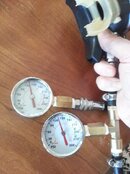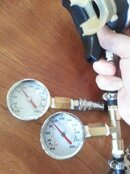I don't think Halo and I are trying to defend the observed Mk10 IP drop, just understand it. I agree - ascribing the IP drop to venturi effects isn't a satisfactory explanation; I just haven't heard a better one until your post. I have seven Mk10's here and ALL of them show a 15-20 psi drop in IP on purge. The fact that they breathe just fine with a balanced adjustable isn't Scubapro loyalty, it's just a fact that at recreational depths with a balanced second stage, breathing flow is subjectively the same over a broad range of interstage pressures.
Your comment that you can see the difference on your workbench (I presume you mean a metered flow device like the A.I.R.) needs explaining. What difference do you see? If you mean that you can generate 14 SCFM flow with only a 5 psi drop in interstage pressure on the bench with one Mk10, but that my reg blowing 14 SCFM will show a 15 psi drop, that's fine, but it doesn't mean anything practically, unless you have two exhausted heavy breathers using two second stages off one Mk10 at 150 feet in an emergency. Short of that, any balanced adjustable second stage (as opposed to a downstream valve) will provide all the flow it's own orifice size will permit whether the IP is 115 or 135, at recreational depths. That's the beauty of air balancing and lighter second stage springs.
Regarding your fix of changing out the main spring, that's fascinating! It corroborates DA Aquamaster's past comments that old springs stiffen up, and means that spring displacement on inhalation is LESS with an old spring at any given tension, so that the flow restriction is right there at the high pressure seat. You imply that a fresh spring will show more displacement for a given IP drop, allowing more space between the piston knife edge and the HP seat, and thus better air flow. That's the best explanation I've heard yet. Can you give us some air bench data?
Where does a DIY guy get fresh Mk10 springs?
---------- Post added May 11th, 2013 at 02:20 PM ----------
Well, this last post got me going. The thought of a 5 psi dynamic IP drop with a "proper" functioning regulator was not believable, so I tested every first stage not in pieces that was sitting around the shop right now:
Piston:
2 Mk5's
2 Mk10's
1 Mk25
2 Atomic T1's
Diaphragm:
1 Apeks ATX200
1 Mk 17
Both first stage basic designs, three different manufacturers, and 25 years of technology improvement.
ALL of them showed a minimum of 20 psi drop on purge, and none of them dropped only 5 psi except on the gentlest inhalation. I didn't put them on the flow bench for real data, just a rough cut. The Atomics and Mk25 blow you away on purge (sorry, I don't have a high flow rotameter to measure over 15 SCFM) and their dynamic drops were the greatest! The Atomic dropped 60psi on full purge, and my hair was flying! I don't think that psi drop was because of poor performance.
I think halo is right. This is a venturi effect somewhere. It's either in my gauge setup, where the orifice of the gauge is like the vacuum inlet of a venturi, or it's in the intermediate chamber itself, where the decrease in flow area at the piston edge is creating the vacuum. Either way, because it's a venturi, the drop in dynamic IP is indicative of HIGHER flow, not lower.
Axxel57, you need to show me some hard data to back up your 5 psi dynamic IP drop claim. I'm no longer buying the spring thing.
RSINGLER
Thanks for answering my post & keeping the thread alive and sorry to let you wait so long, I was quite busy.
As I wrote before I believe that you guys dont feel any difference breathing your SP BAs with your MK10s or for example using an Aqualung Legend.
That is because an inhaling effort increase of 0,1 inch/water needs a 6 - 9psi drop of the static or dynamic IP for a balanced 2
nd, and only 3 6psi for an unbalanced 2
nd.
I think you dont know what a flow test does.
It is not measuring how much a 1
st stage can flow and how much the dynamic IP drop is,
but it is measuring the inhalation effort which is needed to produce a certain amount of flow (at 5 7,5 -10 - 12,5 SCFM) and how much the dynamic IP is dropping.
That is quite something different.
If you purge completely any 2
nd stage combined with any 1
st stage, the dynamic IP will drop the more you purge, that is normal.
If a 1
st stage is capable to flow high amount of air through the system the IP will drop more than in 1sts which from their design cannot flow very high amounts.
Also that is normal.
A MK10 who has a dynamic IP (at high flow 15 25 SCFM) of 20 -25psi is no problem. If its balancing is not working very well between full and low tank or the venturi of the 2
nd stage is not working properly, thats to me more problematic.
Im measuring the inhalation effort at 5 7,5 10 and 12SCFM and I note the dynamic IP at 10SCFM on the test sheet, which is well below the maximum most 1sts can flow.
The basic principle is what matters in the this discussion and it is not that difficult to understand I think.
It is not about the actual number of maybe 5 10 or 15psi IP drop.
Any IP drop will have principally a negative influence on the performance of a 2
nd, because the missing downstream pressure will increase the inhalation effort until it might be compensated by a venturi assist.
Is a 1
st stage with a high dynamic IP drop within the flow, which is needed for recreational diving and beyond, better than one with only a small dynamic IP drop, or doesnt it matter?
I think it matters.
As I mentioned before, a 1
st stage has only one objective, to produce an IP as stable as possible.
So a 1
st stage which is doing its job better and produces a more stable static IP and more stable dynamic IP than another, is the better 1
st stage regardless the fact that lots of divers might feel the difference only in rare and extreme situations.
On my workbench I can see the correlation between the dropping dynamic IP and the increase of the inhaling effort.
This is not just pushing the purge button and watching the IP.
The flow module will suck air from the 2
nd and 1st stage and in the moment the valve cracks open the connected Magnehelic shows an increasing inhalation effort.
The more air flows through the system the more the dynamic IP is dropping and the more the inhalation effort is increasing until the venture assist kicks in, reducing the inhalation effort or even overriding the 2
nd stage mechanism.
That is what I can see on the IP meter and Magnehelic concerning every type of regulators regardless the fact that divers might not feel any difference in normal dives in recreational depth ranges .
In some regulators I see this to only some extend , on others to a much higher extent.
I have not read the post of DA Aquamaster concerning the increasing spring stiffness, but I wrote in another thread that I have frequently to change the SP R295 R190 2nds springs because the springs are becoming with time so stiff that I cannot adjust the cracking effort to manufacturers specification, anyway how I play with the spring tension, IP or the orifice .
Most DYOers probably can confirm that for example with time everybody has to add shims on his MK10 MK20 to produce the needed IP, never to reduce the shims.
So there are springs which are getting stiffer with times and others who are getting weaker (softer), no big deal.
Probably it depends on the material which is used I guess.
So if you still think an obscure venturi is causing the higher dynamic IP and not spring fatigue or the design, then Im probably not able to deliver the hard data you could accept.
Anyway, I have tried to support DYOers by getting them repair manual and schematics and I would not have a problem to get for some of you parts of SP , which are difficult elsewhere to get.
I dont see how I can get you SP parts here from the US without running into problems, but I can also get SP parts in Europe which would be less problematic, but more expensive in transport costs.
But then somebody over there would have to be my contact and organize the distribution.
In the moment Zung would be the only one who comes to my mind.
BTW dont expect too much support from Halocline, he still owes me an answer to my last post in the thread
http://www.scubaboard.com/forums/regulators/432068-little-advice-2nd-stages-please.html and usually does not answer if he feels I might be right in my argumentation.
But maybe he is just waiting Luis or others to back him up

.
Thanks for the discussion!






